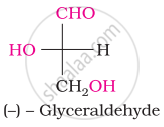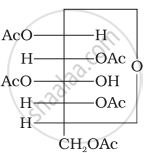Advertisements
Advertisements
प्रश्न
What happens when glucose is treated with hydroxylamine?
उत्तर
Action of hydroxylamine (NH2OH) on glucose: The reaction of glucose with
hydroxylamine gives an oxime. This indicates the presence of carbonyl group.

APPEARS IN
संबंधित प्रश्न
How many moles of acetic anhydride will be required to form glucose pentaacetate from 2M of glucose?
(a) 2
(b) 5
(c) 10
(d) 2.5
Enumerate the reactions of D-glucose which cannot be explained by its open chain structure.
Maltose is a
(a) Polysaccharide
(b) Disaccharide
(c) Trisaccharide
(d) Monosaccharide
What do you observe when glucose solution is heated with Tollen’s reagent?
What do you observe when glucose is treated with bromine water?
Write the reactions involved when D-glucose is treated with the following reagent:
(CH3CO)2O
Choose the appropriate answer(s) for the below representation from the options given


What is the most abundant organic compound on earth?
Glucose does not react with ____________.
Glucose reacts with acetic anhydride to form ______.
Which of the following properties of glucose cannot be explained by its open chain structure?
(i) Glucose does not form hydrogen sulphite with NaHSO3.
(ii) On oxidation with HNO3 glucose gives saccharic acid.
(iii) Glucose is found to exist in two different crystalline forms which are named as α and β.
The reaction of glucose with red P + HI is called ____________.
Which is the least stable form of glucose?
A solution of D-glucose in water rotates the plane polarised light ____________.
The α-D glucose and β-D glucose differ from each other due to difference in carbon atom with respect to its ____________.
The number of chiral carbons in ß-D(+) glucose is ____________.
Which one is correct?
Why does compound (A) given below not form an oxime?

(A)
On the basis of which evidences D-glucose was assigned the following structure?
\[\begin{array}{cc}
\ce{CHO}\\
|\phantom{....}\\
\phantom{..}\ce{(CHOH)4}\\
|\phantom{....}\\
\phantom{..}\ce{CH2OH}
\end{array}\]
Account for the following:
There are 5 OH groups in glucose
Account for the following:
What happens when D – glucose is treated with the following reagents
HNO3
Match List - I with List - II.
| List I | List II | ||
| (A) | Glucose + HI | (I) | Gluconic acid |
| (B) | Glucose + Br2 water | (II) | Glucose pentacetate |
| (C) | Glucose + acetic anhydride | (III) | Saccharic acid |
| (D) | Glucose + HNO3 | (IV) | Hexane |
Choose the correct answer from the options given below:
Give the reaction of glucose with hydrogen cyanide. Presence of which group is confirmed by this reaction?
Give a reason for the following observations:
Penta-acetate of glucose does not react with hydroxylamine.
